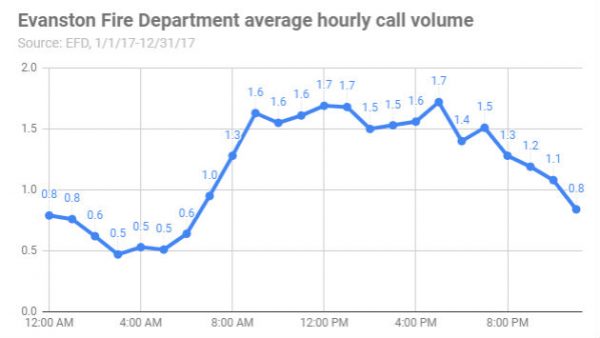Excerpts from evanstonnow.com:
Evanston’s firefighters responded to twice as many calls during the daytime hours than they do at night, but the city’s 24-hour duty schedule for firefighters means staffing doesn’t vary with the predictable shift in demand. While police officers in Evanston work eight-hour shifts, permitting variation in staffing during different day parts, the 24-hour schedule for firefighters precludes that option. That scheduling pattern for the fire service is very common across the country, although a variety of other schedules, including eight and 12 hour shifts and split 10 and 14 hour shifts are also in use.
Calls for service data provided by Fire Chief Brian Scott show that the number of calls for Evanston’s five fire engines, two trucks, and two ambulances range from a low of one call every two hours in the pre-dawn darkness to more than one-and-a-half calls per hour at mid-day. Roughly two out of every three calls are ambulance runs.In addition to an ambulance, a fire engine is dispatched for every ambulance call.
Some reports have raised questions about the health and safety impact of working 24-hour long shifts. And reports are mixed about which pattern is most efficient from a scheduling and overtimestandpoint.
Fire department data shows that Evanston’s ambulances are by far the most heavily used vehicles in the Evanston fire fleet. Ambulance 21 is on calls nearly 29 percent of the time, while Truck 23 is in use less than 7 percent of the time.
The Glenview Fire Department has come up with a partial solution to the varying level of demand across different day parts. It runs two ambulances 24-hours a day and staffs a third ambulance for 12 hours each day — from 7 a.m. to 7 p.m. Glenview’s department serves a population of about 60,000 people in the village and adjacent unincorporated areas with four engines and one truck in addition to its ambulances.
Evanston’s Chief Scott says a third ambulance would help reduce call volume for the existing two ambulances which are extremely busy, but he says given the current budget deficit it would be extremely difficult to fund the addition of even 12 more hours of ambulance service.
The city manager has proposed closing Fire Station 4, which would eliminate the jobs of nine firefighters. If instead of closing the station, which now houses an engine, an ambulance operating for 12 hours a day were stationed there, it would make it possible to reduce the impact of the loss of the engine on service levels while still eliminating six of the nine firefighter jobs proposed to be cut.
































#1 by Bill Post on November 3, 2018 - 11:12 PM
BMH82 Evanston runs a 3rd ambulance as a jump company out of Station 23 at 1105 W Central. Ambulance 23 is only dispatched if both Ambulances 21 and 22 are not available. If Ambulance 23 is dispatched Engine 23 goes out of service. If Engine 23 is not in quarters then they request mutual aid from Skokie or Wilmette.
#2 by BMH 82 on November 3, 2018 - 9:01 AM
Haven’t lived in area for awhile. Did Evanston used to run three ambulances?
#3 by Bill Post on November 2, 2018 - 1:05 AM
Thanks for posting this.I also read the entire article that was published in Evanston Now. The problem it is that the reporter seems to be suggesting that during certain hours there should be companies that are not in service or at the very least less people on duty.
He doesn’t understand that according to ISO standards, they need to have an engine company not more the 1.5 miles away from any built upon areas of a district, which in Evanston’s case is the entire town.
If you go according to NFPA standards which includes standard 1710, the nearest engine needs to be no more than a four minute drive from anywhere in it’s first-due district. If Station 24 is closed that will not be the case for the southwest end of town which is residential and heavily commercial with a busy shopping center.
The reporter also doesn’t know that four people should arrive on scene with the first-due company. Even if Evanston doesn’t take Engine 24 out of service this is not happening. He also doesn’t realize that no matter what time a fire occurs, there is still a need for the same number of people to properly extinguish a fire in it’s initial stages. This includes a RIT and a safety officer and they must be on the scene with not more then an eight minute drive. The original rule 1710 which requires a minimum of 15 firefighters for a two-story dwelling without a basement (using an aerial device) was too small a number because most if not all homes in Evanston and the Chicago area have basements. So there should actually be at least 20 people on the initial response to the scene of a structure fire.
Those standards in and of themselves would or should be able to preclude the ideas that you can run with less men during certain “slow hours”.
The reporter doesn’t seem to get (or at least he doesn’t report) that you must have the same of amount of people on the scene of a fire no what time the fire should occur.